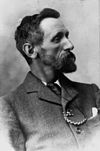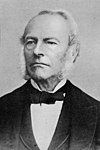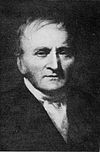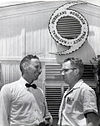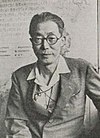Selected biography 1
Portal:Weather/Selected biography/1
Anders Celsius (Swedish pronunciation: [ˈânːdɛʂ ˈsɛ̌lːsɪɵs]; 27 November 1701 – 25 April 1744) was a Swedish astronomer, physicist and mathematician. He was professor of astronomy at Uppsala University from 1730 to 1744, but traveled from 1732 to 1735 visiting notable observatories in Germany, Italy and France. He founded the Uppsala Astronomical Observatory in 1741, and in 1742 proposed (an inverted form of) the Centigrade temperature scale which was later renamed Celsius in his honour. (Full article...)
Previously selected biographies: Robert FitzRoy, More...
Selected biography 2
Portal:Weather/Selected biography/2
Vilhelm Friman Koren Bjerknes ForMemRS (/ˈbjɜːrknɪs/ BYURK-niss, Norwegian: [ˈbjæ̂rkneːs]; 14 March 1862 – 9 April 1951) was a Norwegian physicist and meteorologist who did much to found the modern practice of weather forecasting. He formulated the primitive equations that are still in use in numerical weather prediction and climate modeling, and he developed the so-called Bergen School of Meteorology, which was successful in advancing weather prediction and meteorology in the early 20th century. (Full article...)
Previously selected biographies: Anders Celsius, Robert FitzRoy, More...
Selected biography 3
Portal:Weather/Selected biography/3
Edward Norton Lorenz (May 23, 1917 – April 16, 2008) was an American mathematician and meteorologist who established the theoretical basis of weather and climate predictability, as well as the basis for computer-aided atmospheric physics and meteorology. He is best known as the founder of modern chaos theory, a branch of mathematics focusing on the behavior of dynamical systems that are highly sensitive to initial conditions.
His discovery of deterministic chaos "profoundly influenced a wide range of basic sciences and brought about one of the most dramatic changes in mankind's view of nature since Sir Isaac Newton," according to the committee that awarded him the 1991 Kyoto Prize for basic sciences in the field of earth and planetary sciences. (Full article...)
Previously selected biographies: Vilhelm Friman Koren Bjerknes; Anders Celsius, More...
Selected biography 4
Portal:Weather/Selected biography/4
John Park Finley (April 11, 1854 – November 24, 1943) was an American meteorologist and Army Signal Service officer who was the first person to study tornadoes intensively and pioneer tornado forecasting. He also wrote the first known book on the subject as well as many other manuals and booklets, collected vast climatological data, set up a nationwide weather observer network, started one of the first private weather enterprises, and opened an early aviation weather school. (Full article...)
Previously selected biographies: Edward Norton Lorenz, Vilhelm Friman Koren Bjerknes, More...
Selected biography 5
Portal:Weather/Selected biography/5
Wladimir Petrovich Köppen (/ˈkɜːpən/ KUR-pən; German: [ˈkœpn̩]; Russian: Влади́мир Петро́вич Кёппен, romanized: Vladímir Petróvich Kyoppen, IPA: [vlɐˈdʲimʲɪr pʲɪˈtrovʲɪtɕ ˈkʲɵp(ː)ʲɪn]; 25 September 1846 – 22 June 1940) was a Russian–German geographer, meteorologist, climatologist and botanist. After studies in St. Petersburg, he spent the bulk of his life and professional career in Germany and Austria. The Köppen climate classification system, named after a proposal he first made in 1884, with some modifications, is still widely used. Köppen made significant contributions to several branches of science, and coined the name aerology for the science of the upper atmosphere. (Full article...)
Previously selected biographies: John Park Finley, Edward Norton Lorenz, More...
Selected biography 6
Portal:Weather/Selected biography/6

Robert Allen "Bob" Case (December 16, 1939 – June 19, 2008) was a meteorologist who worked for the National Weather Service (NWS) for 28 years. Over the course of his career, he worked in NWS various offices, developing a diverse background in various types of weather forecasting, including a lengthy stint as a hurricane forecaster. He is best known for inspiring the naming of the 1991 Perfect Storm as The Perfect Storm. (Full article...)
Previously selected biographies: Wladimir Köppen, John Park Finley, More...
Selected biography 7
Portal:Weather/Selected biography/7
Clement Lindley Wragge (18 September 1852 – 10 December 1922) was a meteorologist born in Stourbridge, Worcestershire, England, but moved to Oakamoor, Staffordshire as a child. He set up the Wragge Museum in Stafford following a trip around the world. He was a Fellow of the Royal Geographical Society and in 1879 was elected Fellow of the Royal Meteorological Society in London. To the end of his life, he was interested in theosophy and spiritualism. During his tour of India he met with Mirza Ghulam Ahmad of Qadian, the founder of the Ahmadiyya movement in Islam who had claimed to be the Mahdi, the messianic redeemer awaited by Muslims. Sir Arthur Conan Doyle sought him out in New Zealand to ask for his views on spiritualism before writing The Wanderings of a Spiritualist in 1921. After training in law, Wragge became a meteorologist, his accomplishments in the field including winning the Scottish Meteorological Society's Gold Medal and years later starting the trend of using people's names for cyclones. He travelled widely, giving lectures in London and India, and in his later years was an authority on Australia, India and the Pacific Islands. (Full article...)
Previously selected biographies: Robert Case, Wladimir Köppen, More...
Selected biography 8
Portal:Weather/Selected biography/8
Sir George Gabriel Stokes, 1st Baronet, FRS (/stoʊks/; 13 August 1819 – 1 February 1903) was an Irish mathematician and physicist. Born in County Sligo, Ireland, Stokes spent all of his career at the University of Cambridge, where he was the Lucasian Professor of Mathematics from 1849 until his death in 1903. As a physicist, Stokes made seminal contributions to fluid mechanics, including the Navier–Stokes equations; and to physical optics, with notable works on polarisation and fluorescence. As a mathematician, he popularised "Stokes' theorem" in vector calculus and contributed to the theory of asymptotic expansions. Stokes, along with Felix Hoppe-Seyler, first demonstrated the oxygen transport function of haemoglobin, and showed colour changes produced by the aeration of haemoglobin solutions.
Stokes was made a baronet by the British monarch in 1889. In 1893 he received the Royal Society's Copley Medal, then the most prestigious scientific prize in the world, "for his researches and discoveries in physical science". He represented Cambridge University in the British House of Commons from 1887 to 1892, sitting as a Conservative. Stokes also served as president of the Royal Society from 1885 to 1890 and was briefly the Master of Pembroke College, Cambridge. Stokes's extensive correspondence and his work as Secretary of the Royal Society has led him to be referred to as a gatekeeper of Victorian science, with his contributions surpassing his own published papers. (Full article...)
Previously selected biographies: Clement Lindley Wragge, Robert Case, More...
Selected biography 9
Portal:Weather/Selected biography/9
John Dalton FRS (/ˈdɔːltən/; 5 or 6 September 1766 – 27 July 1844) was an English chemist, physicist and meteorologist. He introduced the atomic theory into chemistry. He also researched colour blindness; as a result, the umbrella term for red-green congenital colour blindness disorders is Daltonism in several languages. (Full article...)
Previously selected biographies: Sir George Stokes, Clement Lindley Wragge, More...
Selected biography 10
Portal:Weather/Selected biography/10
William Ferrel (January 29, 1817 – September 18, 1891) was an American meteorologist who developed theories that explained the mid-latitude atmospheric circulation cell in detail, and it is after him that the Ferrel cell is named. (Full article...)
Previously selected biographies: John Dalton, Sir George Stokes, More...
Selected biography 11
Portal:Weather/Selected biography/11
Robert H. Simpson (November 19, 1912 – December 18, 2014) was an American meteorologist, hurricane specialist, first director of the National Hurricane Research Project (NHRP) from 1955 to 1959, and a former director (1967–1974) of the National Hurricane Center (NHC). He was the co-developer of the Saffir–Simpson Hurricane Scale with Herbert Saffir. His wife was Joanne Simpson. (Full article...)
Previously selected biographies: William Ferrel, John Dalton, More...
Selected biography 12
Portal:Weather/Selected biography/12
Sakuhei Fujiwhara (藤原 咲平, Fujiwara Sakuhei, October 29, 1884 – September 22, 1950) was a Japanese meteorologist who became the namesake for the Fujiwhara effect. Novelist Jirō Nitta is his nephew and mathematician Masahiko Fujiwara is his grandnephew. (Full article...)
Recently selected biographies: William Ferrel, John Dalton, More...
Selected biography 13
Portal:Weather/Selected biography/13
Tetsuya Theodore Fujita (/fuːˈdʒiːtɑː/; FOO-jee-tah) (藤田 哲也, Fujita Tetsuya, October 23, 1920 – November 19, 1998) was a Japanese and American meteorologist whose research primarily focused on severe weather. His research at the University of Chicago on severe thunderstorms, tornadoes, hurricanes, and typhoons revolutionized the knowledge of each. Although he is best known for creating the Fujita scale of tornado intensity and damage, he also discovered downbursts and microbursts and was an instrumental figure in advancing modern understanding of many severe weather phenomena and how they affect people and communities, especially through his work exploring the relationship between wind speed and damage. (Full article...)
Previously selected biographies: Sakuhei Fujiwhara, Robert Simpson, More...
Selected biography 14
Portal:Weather/Selected biography/14
Johannes Peter Letzmann (19 July 1885 – 21 May 1971) was an Estonian meteorologist, and a pioneering tornado researcher. His prolific output related to severe storms concepts included: developing tornado damage studies, atmospheric vortices, theoretical studies and laboratory simulations, tornado case studies, and observation programs. It generated extensive analysis techniques and insights on tornadoes at a time when there was still very little research on the subject in the United States. (Full article...)
Previously selected biographies: Ted Fujita, Sakuhei Fujiwhara, More...
Selected biography 15
Portal:Weather/Selected biography/15
Sir William Napier Shaw FRS (4 March 1854 – 23 March 1945) was a British meteorologist. He introduced the tephigram, a diagram for evaluating convective instability in the atmosphere. He also served as president of the International Meteorological Committee and Royal Meteorological Society. (Full article...)
Previously selected biographies: Johannes Letzmann, Ted Fujita, More...
Selected biography 16
Portal:Weather/Selected biography/16
Christophorus Henricus Diedericus Buys Ballot (Dutch pronunciation: [ˈbœyz bɑˈlɔt]; October 10, 1817 – February 3, 1890) was a Dutch chemist and meteorologist after whom Buys Ballot's law and the Buys Ballot table are named. He was first chairman of the International Meteorological Organization, the organization that would become the World Meteorological Organization. (Full article...)
Previously selected biographies: Sir William Napier Shaw, Johannes Peter Letzmann, More...




